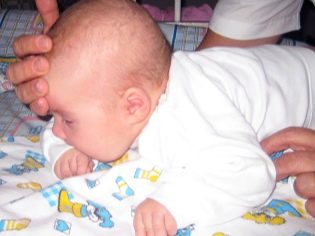How to teach a child to keep his head?
The timeliness of the development of the baby is a painful topic for his parents. Every mother wants the crumb to learn in time to hold her head, smile, roll over, and then sit down - walk. But in practice, everything is such that, how many children, so many terms. Can you teach the baby to hold his head and how to do it, we will tell in this article.
What are the deadlines for orientation?
Waiting for the first physical skill, and the ability to hold the head in an upright position is considered as such, parents forget that the child needs to go quite a long way - his neck muscles should be strong enough to withstand the weight of the head, vertebrae should become stronger. It takes time.
The first attempts to raise the head of healthy kids usually show already in a month and a half. They can not hold their heads for a long time, they get tired quickly. But already in 2 months the children hold the head for about a minute. By 3 months, they are not just holding it, but they can start turning right and left, watching with their eyes an interesting toy or moving mother. At only 5 months old, children begin to raise their heads from a prone position - this type of skill is the most difficult.
The indicated terms are rather conditional. The child may begin to comprehend a new movement a little earlier or a little later. But holding the head too early (1 month or so) is not a reason for pride, but a reason for referring to a neurologist, as this often results in increased intracranial pressure.
The reasons for the lack of skill
Before sounding the alarm and running with the baby to the doctors, parents should take into account all of his individual peculiarities, on which he may later begin to hold his head. Premature babies longer adapt to the new environment, their muscles are weaker, and much more time is needed to strengthen them. There is nothing surprising in the fact that the toddler begins to hold his head only to 3 months.
If the baby is often sick, eats badly, if he suffered a birth trauma, he has congenital defects, then he can master the skill with a significant delay.
Too much weight of the child’s body or body weight deficiency are additional reasons why the baby starts to lift the head slightly later.
You can not ignore the nature of the child. If he prefers to sleep and eat well, then he should not expect early development from him. Another thing - inquisitive and mobile choleric and sanguine. The older they get, the harder it is to keep them in one place.
The reason for the lack of skill in the above terms may be a lack of parental attention. Communication, tactile and emotional contact, strengthening muscles, gymnastics, swimming and walking create the most suitable conditions for learning new movements. The absence of such activities slows the development of the baby.
Sometimes parents notice that the child is trying to hold his head, but it turns out to be crooked - the head is beveled to one side. In this case, it is not excluded torticollisthat requires examination of a children's orthopedist and the appointment of special therapeutic gymnastics and massage, and in some cases - wearing a Schantz collar. By itself, torticollis will not pass, without proper treatment can not do here.
What to do?
Is it possible to teach a child to keep his head - a difficult question. In fact, no, because he will definitely start keeping it, but only when the neck muscles are strong enough. But parents can help them get stronger.To do this, in the daily morning gymnastics, which the mother does to her toddler, from about 3 weeks of life you need to add exercises aimed at strengthening the back and side of the neck muscles.
The task of the parents is not only to teach the child to raise the head, but also to hold it correctly, evenly. It is impossible to quickly teach this, the process of becoming a skill will still be gradual.
Consider the recommendations of doctors and exercises that will contribute to the development of the neck.
- Putting the baby on the belly. Start doing it as soon as the umbilical wound heals in 2.5-3 weeks. First, such an exercise saves the child from the painful infantile colic, contributes to the release of gases. Secondly, large groups of muscles develop - the abdomen, neck, back. At first, the baby will reflexively raise the head and lay it on the cheek so that nasal breathing is not disturbed. Then he will begin to be interested in toys nearby, especially sounding ones, and to raise the head to look at them. Make sure that the baby puts the head on different cheeks - on the right, and the next lesson - on the left.
- Put to sleep on different sides. Sleeping on your side is considered the safest. But if the child lies only on one side, his neck muscles will not be able to develop symmetrically, which will create prerequisites for the development of torticollis. Alternate the right side and the left, putting the baby to bed.
- Teach him to swim. From 1 month mother can use a special circle, which can be bought in an orthopedic salon or a children's store. It is attached to the neck, holding the head. In it, the baby will be able, as a big one, to swim in an adult bath. During such sessions, all muscle groups develop, but the most noticeable result will be precisely in relation to the muscles of the neck and back.
- Carry the baby properly. A vertical position of the body with one and a half months is permissible, but only under the condition that the mother will hold the baby’s head and back. The head should not fall back, then the load rests on the spine.
- Engage on the ball. Fitball will help to strengthen the back muscles of the neck faster, and within a couple of weeks the crumb will start to hold its head.
You will learn more about how to teach a child to hold his head, from the following video.

















